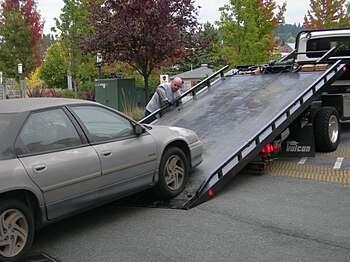There is a wide variety of motor vehicles traveling on and off roads, all of them susceptible to mechanical failure or accidents which may leave them incapacitated and in need of tow. Even vehicles in perfect working order are sometimes towed rather than driven (for example, when a family relocates and want to have their vehicle delivered to their new place of residents).
Due to the infinite possible types of circumstances it is not surprising that there are several types of tow trucks and towing methods. Using the most befitting towing method in each specific case is of great importance.

A car being loaded onto a flatbed tow truck (Photo credit: Wikipedia)
In the following paragraphs you will find a summary of the different methods of towing currently in use along with a brief description of their relative advantages and disadvantages and the way these determine the circumstances in which each method becomes the most suitable one.
Types of Tow Trucks
There are several tow truck manufacturers and a wide range of models which differ greatly from each other, but still, tow trucks can still be divided into three basic types:
• Wheel lift tow trucks
• Hook and chain tow trucks
• Flatbed tow trucks
Tow trucks belonging of the wheel lift type use steel yokes which are hooked and secured under the back or front axles of the towed vehicle. Using hydraulic power (produced by a hydraulic pump driven by the tow truck’s engine) the yoke is raised and lifts the end under which it is attached clear off the ground. The towed vehicle remains with two of its wheels in contact with the road. This method of towing is also commonly referred to as “tow by dolly” or “dolly towing”.
Hook and chain tow trucks are hardly ever used nowadays. Trucks of this kind pull the towed vehicle without it being lifted at all. Chains and hooks are used to attach the towed vehicle to the tow truck (thus the name “hook and chain tow trucks”).
Because this method of towing poses a high risk of damage being inflicted on the towed vehicle, even when it was commonly used it was reserved for vehicles already damaged in car crashes.
Flatbed tow trucks are fast becoming the most common type of tow trucks. Trucks of this type possess a large flat surface (hence the name “flatbed”) onto which towed vehicles are hoisted. Vehicles to be towed are pulled onto the flatbed using an electric winch, once all of the towed vehicle’s wheels lay on the flatbed at the back of the tow truck the vehicle is secured tightly ensuring there in no chance of it rolling off (or moving at all for that matter) during the tow.
Advantages of Flatbed Towing
Flatbed towing is considered the safest method of towing. It is important that the pulling of the towed vehicle onto the flatbed is carried out carefully by a professional tow tech as great forces are exerted on the winch and wire as well as on the vehicle being pulled itself.
Once the towed vehicle is hoisted and secured driving a flatbed tow truck in tow is substantially easier than driving a wheel lift tow truck. This fact allows for easier navigation through traffic, making the whole process safer and faster.
There are circumstances when flatbed towing is the only option, such as with motorcycle towing or with vehicles badly damaged in traffic accidents.
Advantages of Towing by Dolly
Wheel lift type tow trucks used in dolly towing may be smaller and less powerful than even the smallest flatbed tow trucks. This may make dolly towing the most efficient choice for light duty local towing jobs.
On the other hand there are heavy, cumbersome vehicles (motor homes for instance) which are too big to fit on a regular flatbed tow truck but can still be towed by a powerful enough wheel lift tow truck.
Thank you to Pine Towing for the very informative article. Please visit them at http://towrichmond.com/ if you wish to find out more.
Posted under Car Tips
This post was written by admin on December 30, 2014




